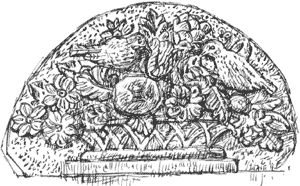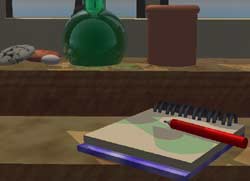 |
I've noticed only one appearance of
birds on the Victorian monuments in Horbury cemetery so I couldn't
resist drawing it; this delightful motif from the headstone of
Oliver Roberts (1823-1867) of Healey, Ossett, includes
cones, oak leaves, an acorn, a peach (?) and some cabbage-like flowers. |
| The headstone of Joseph
Fallas (1810-1876), 'builder of Horbury', is the
only example I found of tools of the trade being shown on a memorial.
For a moment I wondered if this was a free mason's grave. It's also
unusual, at least in this older part of the cemetery, for the mason's
name to be carved on the front of the stone, bottom left, as it
is here: 'H. FALLAS, HORBURY'.
They kept up the family tradition of building for several generations.
Horbury Town Hall, dating from 1902, was built by Henry Fallas and
Son.
The headstone of William Sykes, founder of what
would become Slazenger's sporting goods manufacturers, features
cricket stumps and originally also included bails, bat and ball,
but they've been stolen. |
 |
|
|
Tractor
I spotted this old tractor a month or so ago as we drove past Sowood
Farm, on the boundary between Horbury and Ossett. It's a delight
to draw. After the sentimentality of the Victorian birds and flowers
I drew this morning I find this a welcome change; it couldn't be
more down to earth.
I couldn't help but adapt to the fussiness of the Victorian decoration
as I drew it but the form-follows-function simplicity of the old
tractor is more to my taste. It has developed an individual character
through the knocks and bumps and tarnished patina that it has accumulated
during years of rough weather and hard work.
The tractors lie about our fields; at evening
They look like dank sea-monsters crouched and waiting.
We leave them where they are and let them rust:
“ They'll molder away and be like other loam.”
Edwin Muir, The Horses
|
 Sketchbook Sketchbook
After drawing in the real world it's interesting to create something
in three dimensions on the computer. My skills so far don't go much further
than using component parts - cylinders, spheres, cubes and cones - like
building bricks. The pencil for instance is a cone placed on top of an
elongated cylinder, built for ease of manipulation as a gigantic tower
but soon brought down to the scale of the rest of this still life.
Artists materials would be fun to model; they're simple shapes and, once
you've gone to the trouble of creating one pencil or paint tube, you can
soon turn out a series of them in different colours.

Richard Bell, richard@willowisland.co.uk
|
![]()